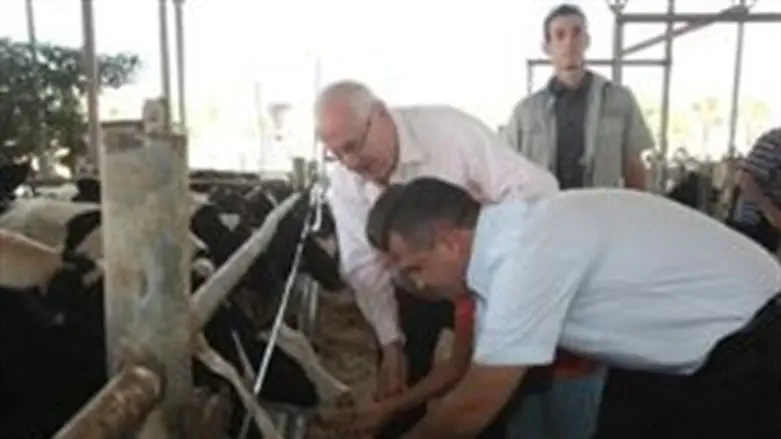
Members of the Knesset’s Finance Committee and representatives of Israel’s Dairy Council visited on Thursday the dairy barn in Shomria which belongs to the former residents of Atzmona, a Gush Katif community which was evacuated as part of the 2005 disengagement plan.
The purpose of the visit was to talk with the farmers and hear about the harsh conditions in which they work, ahead of a possible decision on reducing the prices of dairy products. The move to reduce the cost of dairy products began in the wake of the cottage cheese protest which began as a protest on Facebook and subsequently escalated to a debate in the Knesset.
Consumers complained that cottage cheese is a basic product that has reached outrageous prices and called on the government and the dairies to reduce its prices. The protest seemed to work and the dairies (such as Tnuva and Strauss) reduced the prices. Last week, Industry and Trade Minister Shalom Simhon announced that dairy prices will be reduced about 10% and that dairies will be forced to reduce profit margins accordingly.
Other measures taken included a reduction in dairy tariffs to allow imports of less expensive powdered milk and hard cheeses, and the opening of competition in the price of milk, which should lead to a considerable drop in the cost of raw milk. But the announcement about the lowering of dairy prices has left the dairy farmers worried, and Atzmona and Shomria secretary Zevulun Kalfa told Arutz Sheva on Thursday that he hopes that the lowering will not come at the expense of the farmers.
“The dairy farmers work very hard to produce income,” Kalfa said. “We explained to the committee members that agriculture is not just a living but is mainly a value of the settlement of Israel. Harming agriculture is like assaulting the idea of the settlement of the land. Dairy farming in southern Israel is also very important for maintaining the national land.”
Kalfa added that damage to the dairy industry and the dairy farmers will result in a mass abandoning of lands.
“If the profitability of farmers and farms is hurt, it could lead to abandonment of land,” he said. “Unfortunately it always repeats itself: the farmer sweats and spills his blood and gets a pittance in return while other hands make all the profits. We take the risk and the manufacturers of dairy products are the ones who make the greatest profit. If they want to reduce the dairy prices they should do so by setting price steps, not by hurting us.”
Kalfa pointed out that the members of Atzmona had managed to rebuild the Shomria dairy barn after the expulsion from Gaza and make it profitable.
“In Gush Katif there was a barn which was shared by Atzmona and Katif,” he said. “After the expulsion the barn went for a number of years to Be’er Tuvia and then was split between the residents of Atzmona and the residents of Katif. We got a barn with losses of 4 million shekels and turned it into a magnificent and profitable barn. The barn today has 400 cows, 260 of which are dairy cows. The dairy industry is flourishing alongside other agricultural industries that flourish in Shomria such as the oil industry, the wine and chicken coops.”
